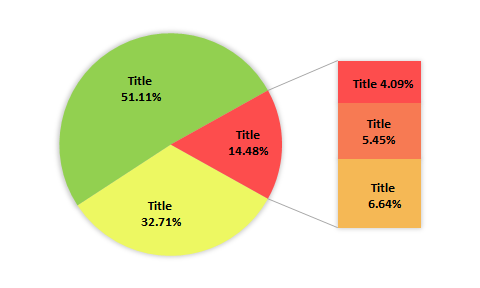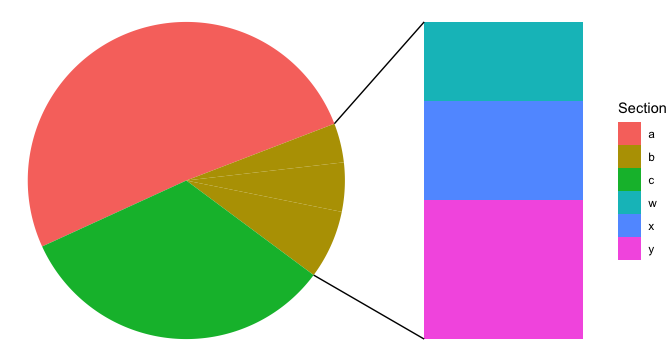This seemed like an interesting problem. I'm sure there are functions and packages out there that will do a lot of this work, but I reinvented a few wheels just because I wanted explore how to put things together. The result is some working code. It's ugly, a little chaotic, but functional. Hopefully it helps you put together a solution that fits your needs.
First, you will need to run all of this code in your session
#--------------------------------------------------------------------
# Source in all of these functions together.
#
# CONTENTS ----------------------------------------------------------
#
# dual_chart - Master function. It will combine two charts and either
# print the plot object, or return the two plots in a list
# where they can be further customized.
# dual_chart_combine - Does the work of putting the two plots side by side.
# dual_chart_pie - Construct the pie chart.
# dual_chart_bar - Construct the bar chart.
# dual_chart --------------------------------------------------------
# Master function. It will combine two charts and either
# print the plot object, or return the two plots in a list
# where they can be further customized.
dual_chart <- function(data, primary_variable, level_for_detail,
secondary_variable,
ncol = 2, nrow = 1, ...,
plot = TRUE){
plots <- list(pie = dual_chart_pie(DF,
primary_variable,
level_for_detail),
bar = dual_chart_bar(DF,
primary_variable,
level_for_detail,
secondary_variable))
if (plot){
dual_chart_combine(plots$pie,
plots$bar,
ncol = ncol,
nrow = nrow,
...)
} else {
plots
}
}
# dual_chart_combine ------------------------------------------------
# Does the work of putting the two plots side by side.
dual_chart_combine <- function(pie_chart, bar_chart,
ncol = 2, nrow = 1, ...){
gridExtra::grid.arrange(
grobs = list(pie_chart, bar_chart),
ncol = ncol,
nrow = nrow
)
}
# dual_chart_pie ----------------------------------------------------
# Construct the pie chart
dual_chart_pie <- function(data, primary_variable, level_for_detail){
require(dplyr)
require(ggplot2)
# Frequency and Relative Frequencies of the data
primary_summary <-
data %>%
group_by_at(primary_variable) %>%
summarise_at(primary_variable,
.funs = list(n = function(x) sum(!is.na(x)))) %>%
mutate_at("n",
.funs = list(p = function(x) x / sum(x)))
# Determine the radian shift.
# This allows us to place the level_for_detail on the right side of the
# pie chart, with the slice of the pie centered over the pi/2 position.
# label_position determines the y-coordinate for the proportion label.
cum_freq <- c(0, cumsum(primary_summary$p))
radian_position <- cum_freq * 6.283
radian_shift <- numeric(length(cum_freq) - 1)
names(radian_shift) <- primary_summary[[primary_variable]]
label_position <- numeric(length(cum_freq) - 1)
for (i in seq_along(radian_shift)){
radian_shift[i] <- mean(radian_position[c(i, i+1)])
label_position[i] <- mean(cum_freq[c(i, i + 1)])
}
# Make the pie chart
ggplot(data = primary_summary,
mapping = aes_string(y = "p",
fill = primary_variable)) +
geom_bar(width = 1,
stat = "identity",
mapping = aes(x = "")) +
geom_text(mapping = aes_string(y = "1 - label_position",
label = "p"),
x = 1) +
coord_polar("y",
start = pi / 2 + radian_shift[level_for_detail])
}
# dual_chart_bar ----------------------------------------------------
# Construct the bar chart
dual_chart_bar <- function(data, primary_variable, level_for_detail,
secondary_variable){
secondary_summary <-
data %>%
group_by_at(c(primary_variable, sub_variable)) %>%
summarise_at(sub_variable,
.funs = list(n = function(x) sum(!is.na(x)))) %>%
ungroup() %>%
mutate_at("n",
.funs = list(p = function(x) x / sum(x))) %>%
filter_at(primary_variable, any_vars(. %in% level_for_detail))
# label_position determines the y-coordinate for the proportion label.
cum_freq <- c(0, cumsum(secondary_summary$p))
label_position <- numeric(length(cum_freq) - 1)
for (i in seq_along(label_position)){
label_position[i] <- mean(cum_freq[c(i, i + 1)])
}
# Make the bar plot
ggplot(data = secondary_summary,
mapping = aes_string(y = "p",
fill = sub_variable)) +
geom_bar(width = 1,
stat = "identity",
mapping = aes(x = "")) +
geom_text(mapping = aes_string(y = "max(cum_freq) - label_position",
label = "p"),
x = 1)
}
Once that's all in there, you can get the crude plot with
dual_chart(DF, "pie_var", "C", "bar_var")


